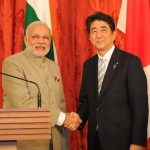IDR Blog
India must balance Indo-Pacific policy between China and US
While addressing students at the Nanyang Technological University (NTU), Singapore and while delivering the keynote address at the annual Shangri La Dialogue, Prime Minister Narendra Modi unequivocally pitched for robust ties between India and China, while again referring to the 21st century as the Asian century.
In his keynote address at the Shangri La Dialogue, Modi said, “I firmly believe that Asia and the world will have a better future when India and China work together in trust and confidence..India-China cooperation is expanding. Trade is growing. And, we have displayed maturity and wisdom in managing issues and ensuring a peaceful border.”
Addressing students at the NTU, Modi also spoke of the 21st century as ‘Asia’s Century’: “The world is clear that the 21st century is Asia’s century. It is essential to believe in ourselves and know that this is our turn.”
The past few months have witnessed a significant shift in India’s approach towards China. Modi visited China on April 27 and met with Chinese President Xi Jinping at Wuhan. During their ‘informal’ summit, not only were bilateral issues discussed, but key global economic developments (specifically, the insular policies being adopted by the US) were raised. Both China and India also decided to work jointly in Afghanistan on an economic development project.
New Delhi is trying to improve ties with Beijing and reboot ties with Moscow. This was evident from Modi’s visit to Russia, where a number of international issues were discussed, including the US withdrawal from the Iran nuclear agreement and India’s position on the purchase of S-400 Air Defence Systems from Russia. Sections of the US establishment are not comfortable with this purchase, and have pitched for imposing sanctions on India, under CAATSA, though Defence Secretary James Mattis has advised against such a move. India has, however, made clear that it will go ahead with the purchase, which it considers essential for its own defence and security interests.
It is not just India which is recalibrating its foreign policy. As a consequence of US President Donald Trump’s inward looking economic policies and lack of nuance on complex strategic issues, Trump has compelled a steadfast ally like Japan to reach out to China. In April 2018, Chinese Foreign Minister Wang Yi visited Japan and held discussions on several key strategic and economic issues. In May 2018, Chinese Premier Li Keqiang visited Japan to commemorate 40 years of the China-Japan Treaty of Peace and Friendship. Japan and China even discussed the possibility of cooperating on the Belt and Road Initiative (BRI). Japanese companies already are participating in parts of the BRI.
New Delhi is part of the narrative of the ‘Asian Century’ and needs to work closely with China, as well as with organizations like BRICS and Shanghai Cooperation Organisation, (where India, China and Russia must work together on various issues) where there are significant differences with Washington on economic and strategic issues.
On the other hand, there is also an increasing emphasis on the need for a free and fair ‘Indo-Pacific,’ driven by the US (of which India is a key component). While Trump may be unpredictable on economic issues, and inward looking, he has used this term on more than one occasion, much to Beijing’s disapproval. Former Secretary of State, Rex Tillerson too outlined a vision for the Indo-Pacific, making India an important stakeholder in this narrative. The Quad grouping (comprising Japan, India, US, Australia) was revived and officials of all four countries met on the sidelines of the East Asia Summit in November 2017, re-emphasizing the need for a ‘free and fair Indo-Pacific’.
More recently, the US Pacific Command has been renamed the Indo-Pacific Command.
Mattis, speaking at the change of command ceremony in Hawaii, where the Command is headquartered, said,
“In recognition of the increasing connectivity between the Indian and Pacific Oceans, today we rename the US Pacific Command to US Indo-Pacific Command.”
The Quad grouping has spoken of the need to develop an alternative to the BRI, though there is no clarity about specifics. This is a major shortcoming of the group and, with Japan and the US having differences on the issue of North Korea, it remains to be seen whether the Quad can formulate a clear agenda and not just slogans.
India thus needs to straddle different narratives and its foreign policy cannot be driven by dogma of any sort.
Modi, at the Shangri-La Dialogue said, “Our vision stands for a free, open, inclusive region, which embraces us all in a common pursuit of progress and prosperity.”
India does realize the limitations of the Indo-Pacific narrative or the ‘Quad.’ The Indian decision to refuse Australian participation in the Malabar Exercises to be held in Guam (June 6-15, 2018) is a reiteration of this policy.
New Delhi needs to have a reasonable relationship with China, but not allow its external outreach to be dictated by Beijing’s sensitivities. Similarly, while ties have strengthened with the US, there will be economic issues and geo-political issues like Iran where New Delhi will not toe Washington’s line.
Balancing its relationships will become easier through domestic progress and robust economic growth. India can be an important stakeholder even in projects like the ‘Indo-Pacific Economic Corridor’ if it has greater economic resources. The slogans and rhetoric aside, New Delhi now needs to focus on its economy, and ‘transformative policies’ should be a reality not a mere electoral slogan.




